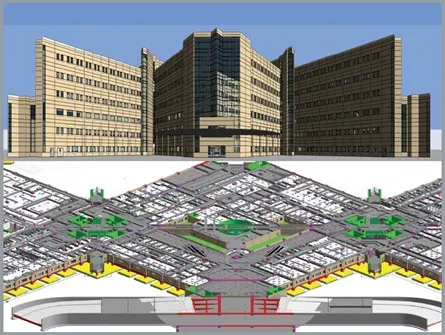In the rapidly advancing architecture, engineering, and construction (AEC) industry, Building Information Modeling (BIM) has emerged as a game-changing technology that streamlines project delivery and improves collaboration among stakeholders.
However, it remains somewhat of a mystery to the many stakeholders involved, leading to suboptimal use of technology, increased costs, and missed opportunities.
Dispelling BIM myths is essential because understanding BIM capabilities can enable stakeholders to:
- Increase project efficiency and improve collaboration
- Reduce errors in the design or construction phase that eventually reflect in excessive costs and project delays
- Set realistic expectations about project success, estimated cost and time of completion
- Get integrated project delivery and improve product quality
When applied correctly, BIM can help construction companies make better decisions and reduce costs, making buy-in from teams and stakeholders easier. For architects, contractors, engineers, designers and building engineering consultants, it becomes critical to address myths surrounding BIM and continuously adapt to the changing landscape.
BIM Misconception #1: BIM is just 3D modeling
Fact: BIM is an intelligent, information-rich, 3-dimensional model-based system.
While 3D modeling and BIM both involve creating visual representations of structures, there are significant differences between them.
- Intelligence and data: BIM models are more than just 3D representations; they contain detailed data on structural properties, performance characteristics, and specifications for each building component. The real time data updates enable informed decision making.
- Collaboration: BIM enables architects, engineers, real estate developers, and contractors to plan, design, and construct buildings within one 3D BIM model, facilitating better collaboration and communication among project stakeholders.

An interesting project where BIM’s data management capabilities made a significant impact was the construction of an International Airport Terminal in the Middle East. Since it was a busy airport, the construction company needed to ensure that the construction work was carried on without disrupting the current operations of other terminals. There were multiple areas of the airport terminal that needed work, for which architectural, structural and MEPF BIM models were needed.
The project team used BIM to coordinate the design and construction of the complex structure, which included office buildings and various passenger terminals. Using BIM, the team created a clash-free and coordinated 3D Revit model at LOD 400 ensuring the MEPF model and layouts were in harmony with architectural and structural designs. The 360-degree visualization enabled the team to make smart and informed decisions leading to huge time and cost savings and hassle-free MEP installations.
BIM Misconception #2: BIM implementation is expensive and time consuming
Fact: The ROI from BIM implementation is high, although it initially takes some time.
The initial costs associated with BIM implementation, including software, training, and transition, may be a little high, but the ROI is significantly high.
- Software costs: BIM software may require an up-front investment, but the benefits of improved project management and collaboration can outweigh these costs.
- Training costs: Training employees to use BIM tools is essential for successful implementation, but increased efficiency and reduced errors can balance the investment.
- Transition time: Implementing BIM may initially slow down the design process, but with proper planning and resource allocation, long-term benefits can be realized.
Eventually, the long-term ROI is significant due to accurate data representation and data-driven decisions, as BIM enables higher efficiency in processes, reduces overall risk, and leads to money savings. In fact, many companies are increasingly choosing to outsource their projects to reliable BIM service providers.
A European real estate management firm used BIM modeling to optimize and automate their workflows and processes. Revit automation using Dynamo helped the client save 50% on time and 18% on project costs.
BIM Misconception #3: BIM is only for architects
Fact: BIM is a useful tool that is adopted by various professionals across the AEC space, including engineers, designers, contractors, and facility managers.
BIM is used by various AEC stakeholders to solve clashes or conflicts with objects of the same model that may occur between different disciplines, streamlining the entire design and construction process.
By integrating different disciplines such as architectural, structural and MEPF into a single or centralized model, BIM enables several teams to resolve potential clashes and conflicts in a timely manner during the pre-construction stage. This results in reducing the impact of costly rework and delays on project timelines. This collaborative environment fosters better communication and coordination among project stakeholders, leading to more efficient and successful projects.
One example of a multidisciplinary project is of a data center in Asia. A clash-free and coordinated 3D BIM model in Autodesk Revit was created for architectural, structural, and MEPF disciplines. The early clash detection eliminated potential design clashes early during the design development stage, leading to reduced rework and savings of cost and time during actual construction.

BIM Misconception #4: Traditional methods are just as effective
Fact: Traditional methods often lead to inaccuracies, BIM provides enhanced accuracy, efficiency, and collaboration.
While traditional methods may have their merits, they often result in a lot of manual work and errors. BIM allows for improved spatial awareness and accuracy by providing a 360-degree representation of the building, enabling better visualization and project understanding. This helps to reduce on-site errors and ensure that every element fits perfectly.
It also encourages interdisciplinary collaboration by consolidating all design information into a single and shared model. This allows various teams involved in a construction project to work together in real-time, improving communication and coordination among project stakeholders.
With real-time updates and insights, BIM allows project managers to monitor project progress and make necessary adjustments. This helps in reducing on-site errors and improving overall project efficiency.

BIM Misconception #5: BIM does not offer much value after the construction phase
Fact: BIM is beneficial throughout the construction lifecycle, especially in facility management and future renovations.
3D BIM models are information rich and contain information about materials, components, and equipment used in construction. This data can be invaluable when renovations are required, as a BIM model offers an accurate representation of the existing building, eliminating the need for extensive new surveys or measurements.
BIM can also be seamlessly integrated with building systems to provide real-time data about building performance, energy usage, and occupancy patterns. This information can help facility managers optimize building operations, reduce energy consumption, and improve overall efficiency.
A project management solutions firm created a 3D BIM model at LOD 500 as per AIA standards, for MEP, architectural and structural disciplines for a hospital project in Saudi Arabia. This information rich model not only helped them gain an in-depth understanding of the building’s performance, but also enabled better decision-making and improved facility management.

BIM’s Transformative Impact on Building Engineering
- Enhanced collaboration between architects, engineers, contractors, etc.
- Better visualization and analysis of building systems
- Seamless project execution
- Engineers can extract accurate quantity take-offs and generate cost estimations in real-time
- Access detailed information about building components, warranty details, replacement schedules, and more, facilitating proactive facility management
- Integration with IoT enables real-time monitoring of building systems, paving the way for smart building solutions
BIM Best Practices
Here are a few practical tips for the successful implementation of BIM in your organization:
- Identify an experienced BIM partner
- Develop a comprehensive BIM Implementation Plan (BIP)
- Set clear goals and objectives for BIM adoption
- Establish and follow BIM standards and protocols
- Invest in proper training for employees
- Choose the right BIM software and tools
- Foster interdisciplinary collaboration
- Monitor progress and make necessary adjustments
- Evaluate and measure the success of BIM implementation
Along with this, setting clear standards and protocols are essential for successful BIM implementation, as they:
- Ensure consistency and quality in BIM models
- Facilitate collaboration and communication among project stakeholders
- Help in managing project costs, improving quality, and reducing overall project time
Conclusion
In summary, by debunking BIM myths and adopting BIM best practices, the AEC industry can benefit from improved accuracy, efficiency, and collaboration.
It is essential for professionals to explore BIM’s potential, dispel their misconceptions, and fully embrace the future of construction and design.










